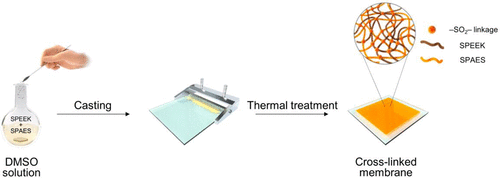当前位置:
X-MOL 学术
›
ACS Appl. Energy Mater.
›
论文详情
Our official English website, www.x-mol.net, welcomes your feedback! (Note: you will need to create a separate account there.)
Simple and Effective Cross-Linking Technology for the Preparation of Cross-Linked Membranes Composed of Highly Sulfonated Poly(ether ether ketone) and Poly(arylene ether sulfone) for Fuel Cell Applications
ACS Applied Energy Materials ( IF 6.4 ) Pub Date : 2020-09-25 , DOI: 10.1021/acsaem.0c01527 Hyunhee Lee 1 , Jusung Han 1 , Su Min Ahn 2 , Hwan Yeop Jeong 2 , Junghwan Kim 1 , Hyejin Kim 1 , Tae-Ho Kim 2 , Kihyun Kim 3 , Jong-Chan Lee 1
ACS Applied Energy Materials ( IF 6.4 ) Pub Date : 2020-09-25 , DOI: 10.1021/acsaem.0c01527 Hyunhee Lee 1 , Jusung Han 1 , Su Min Ahn 2 , Hwan Yeop Jeong 2 , Junghwan Kim 1 , Hyejin Kim 1 , Tae-Ho Kim 2 , Kihyun Kim 3 , Jong-Chan Lee 1
Affiliation

|
Cross-linking technology has been considered as one of the effective strategies for improving the physicochemical stability of proton-exchange membranes (PEMs) for fuel cell applications. However, the complicated procedure, which consists of various reagents and multiple steps to form the proton-conducting cross-linked membranes, has been known to be disadvantageous to increasing the application of the cross-linking method. In this study, we present a simple and effective cross-linking technology for the development of high-performance cross-linked PEMs without any tedious chemical processes and catalysts or additives. A series of cross-linked membranes could be prepared by a simple one-step stage of casting and heating the mixture of sulfonated poly(ether ether ketone) (SPEEK) and sulfonated poly(arylene ether sulfone) (SPAES) in dimethyl sulfoxide (DMSO) solution, where DMSO works as the solvent and the reagent at the same time without any tedious chemical reaction steps. By controlling the cross-linking density, cross-linked membranes having tunable physicochemical stabilities and mechanical properties with outstanding proton conductivity could be obtained. The fuel cell performance of the membrane electrode assembly employing the cross-linked membrane with the optimum cross-linking density and composition ratio showed a maximum power density of 0.70 W cm–2, which was superior to that employing Nafion 212 (0.58 W cm–2) at 80 °C under fully humidified H2/air condition.
中文翻译:

一种简单有效的交联技术,用于制备燃料电池用高磺化聚醚醚酮和聚亚芳基醚砜的交联膜
交联技术已被视为改善用于燃料电池的质子交换膜(PEM)的物理化学稳定性的有效策略之一。然而,已知由各种试剂和多个步骤组成的形成质子传导性交联膜的复杂程序不利于增加交联方法的应用。在这项研究中,我们提出了一种简单有效的交联技术,用于开发高性能的交联PEM,而无需任何繁琐的化学过程和催化剂或添加剂。可以通过简单的一步法浇铸和加热磺化聚醚醚酮(SPEEK)和磺化聚亚芳基醚砜(SPAES)在二甲亚砜(DMSO)中的混合物来制备一系列交联膜)溶液,其中DMSO同时用作溶剂和试剂,无需任何繁琐的化学反应步骤。通过控制交联密度,可以获得具有可调节的理化稳定性和具有优异的质子传导性的机械性能的交联膜。使用具有最佳交联密度和组成比的交联膜的膜电极组件的燃料电池性能显示最大功率密度为0.70 W cm DMSO同时用作溶剂和试剂,而无需任何繁琐的化学反应步骤。通过控制交联密度,可以获得具有可调节的理化稳定性和具有优异的质子传导性的机械性能的交联膜。使用具有最佳交联密度和组成比的交联膜的膜电极组件的燃料电池性能显示最大功率密度为0.70 W cm DMSO同时用作溶剂和试剂,而无需任何繁琐的化学反应步骤。通过控制交联密度,可以获得具有可调节的理化稳定性和具有优异的质子传导性的机械性能的交联膜。使用具有最佳交联密度和组成比的交联膜的膜电极组件的燃料电池性能显示最大功率密度为0.70 W cm–2优于在80°C的全湿H 2 /空气条件下使用Nafion 212(0.58 W cm –2)的情况。
更新日期:2020-11-23
中文翻译:

一种简单有效的交联技术,用于制备燃料电池用高磺化聚醚醚酮和聚亚芳基醚砜的交联膜
交联技术已被视为改善用于燃料电池的质子交换膜(PEM)的物理化学稳定性的有效策略之一。然而,已知由各种试剂和多个步骤组成的形成质子传导性交联膜的复杂程序不利于增加交联方法的应用。在这项研究中,我们提出了一种简单有效的交联技术,用于开发高性能的交联PEM,而无需任何繁琐的化学过程和催化剂或添加剂。可以通过简单的一步法浇铸和加热磺化聚醚醚酮(SPEEK)和磺化聚亚芳基醚砜(SPAES)在二甲亚砜(DMSO)中的混合物来制备一系列交联膜)溶液,其中DMSO同时用作溶剂和试剂,无需任何繁琐的化学反应步骤。通过控制交联密度,可以获得具有可调节的理化稳定性和具有优异的质子传导性的机械性能的交联膜。使用具有最佳交联密度和组成比的交联膜的膜电极组件的燃料电池性能显示最大功率密度为0.70 W cm DMSO同时用作溶剂和试剂,而无需任何繁琐的化学反应步骤。通过控制交联密度,可以获得具有可调节的理化稳定性和具有优异的质子传导性的机械性能的交联膜。使用具有最佳交联密度和组成比的交联膜的膜电极组件的燃料电池性能显示最大功率密度为0.70 W cm DMSO同时用作溶剂和试剂,而无需任何繁琐的化学反应步骤。通过控制交联密度,可以获得具有可调节的理化稳定性和具有优异的质子传导性的机械性能的交联膜。使用具有最佳交联密度和组成比的交联膜的膜电极组件的燃料电池性能显示最大功率密度为0.70 W cm–2优于在80°C的全湿H 2 /空气条件下使用Nafion 212(0.58 W cm –2)的情况。



























 京公网安备 11010802027423号
京公网安备 11010802027423号